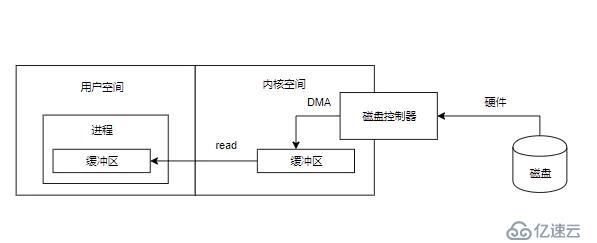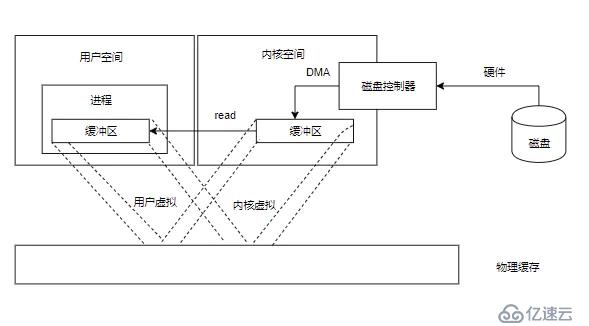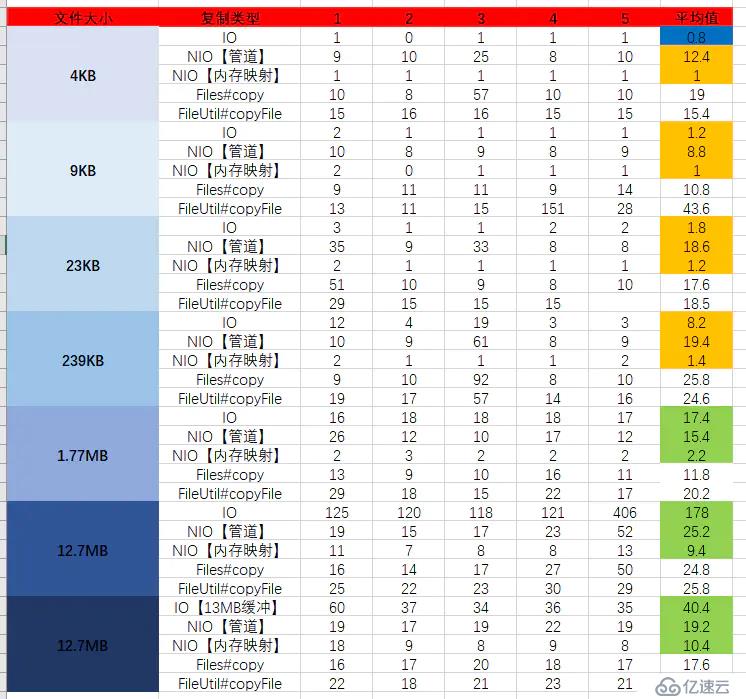最近项目里有个需求需要实现文件拷贝,在java中文件拷贝流的读写,很容易就想到IO中的InputStream和OutputStream之类的,但是上网查了一下文件拷贝也是有很多种方法的,除了IO,还有NIO、Apache提供的工具类、JDK自带的文件拷贝方法
public class IOFileCopy {
private static final int BUFFER_SIZE = 1024;
public static void copyFile(String source, String target) {
long start = System.currentTimeMillis();
try(InputStream in = new FileInputStream(new File(source));
OutputStream out = new FileOutputStream(new File(target))) {
byte[] buffer = new byte[BUFFER_SIZE];
int len;
while ((len = in.read(buffer)) > 0) {
out.write(buffer, 0, len);
}
System.out.println(String.format("IO file copy cost %d msc", System.currentTimeMillis() - start));
} catch (Exception e) {
e.printStackTrace();
}
}
}传统IO中文件读取过程可以分为以下几步:
内核从磁盘读取数据到缓冲区,这个过程由磁盘操作器通过DMA操作将数据从磁盘读取到内核缓冲区,该过程不依赖CPU
用户进程在将数据从内核缓冲区拷贝到用户空间缓冲区

NIO进行文件拷贝有两种实现方式,一是通过管道,而是通过文件内存内存映射
public class NIOFileCopy {
public static void copyFile(String source, String target) {
long start = System.currentTimeMillis();
try(FileChannel input = new FileInputStream(new File(source)).getChannel();
FileChannel output = new FileOutputStream(new File(target)).getChannel()) {
output.transferFrom(input, 0, input.size());
} catch (Exception e) {
e.printStackTrace();
}
System.out.println(String.format("NIO file copy cost %d msc", System.currentTimeMillis() - start));
}
}文件内存映射:
把内核空间地址与用户空间的虚拟地址映射到同一个物理地址,DMA 硬件可以填充对内核与用户空间进程同时可见的缓冲区了。用户进程直接从内存中读取文件内容,应用只需要和内存打交道,不需要进行缓冲区来回拷贝,大大提高了IO拷贝的效率。加载内存映射文件所使用的内存在Java堆区之外
public class NIOFileCopy2 {
public static void copyFile(String source, String target) {
long start = System.currentTimeMillis();
try(FileInputStream fis = new FileInputStream(new File(source));
FileOutputStream fos = new FileOutputStream(new File(target))) {
FileChannel sourceChannel = fis.getChannel();
FileChannel targetChannel = fos.getChannel();
MappedByteBuffer mappedByteBuffer = sourceChannel.map(FileChannel.MapMode.READ_ONLY, 0, sourceChannel.size());
targetChannel.write(mappedByteBuffer);
} catch (FileNotFoundException e) {
e.printStackTrace();
} catch (IOException e) {
e.printStackTrace();
}
System.out.println(String.format("NIO memory reflect file copy cost %d msc", System.currentTimeMillis() - start));
File targetFile = new File(target);
targetFile.delete();
}
}NIO内存映射文件拷贝可以分为以下几步

NIO的内存映射实际上就是少了一次从内核空间拷贝到用户空间的过程,将对用户缓冲区的读改为从内存读取
public class FilesCopy {
public static void copyFile(String source, String target) {
long start = System.currentTimeMillis();
try {
File sourceFile = new File(source);
File targetFile = new File(target);
Files.copy(sourceFile.toPath(), targetFile.toPath());
} catch (IOException e) {
e.printStackTrace();
}
System.out.println(String.format("FileCopy file copy cost %d msc", System.currentTimeMillis() - start));
}
}使用FileUtils之前需先引入依赖
依赖
<dependency>
<groupId>commons-io</groupId>
<artifactId>commons-io</artifactId>
<version>2.4</version>
</dependency>FileUtils#copyFile封装类:FileUtilsCopy.java
public class FileUtilsCopy {
public static void copyFile(String source, String target) {
long start = System.currentTimeMillis();
try {
FileUtils.copyFile(new File(source), new File(target));
} catch (IOException e) {
e.printStackTrace();
}
System.out.println(String.format("FileUtils file copy cost %d msc", System.currentTimeMillis() - start));
}
}既然有这么多种实现方法,肯定要从中选择性能最佳的
测试环境:
测试代码:PerformTest.java
public class PerformTest {
private static final String source1 = "input/test1.txt";
private static final String source2 = "input/test2.txt";
private static final String source3 = "input/test3.txt";
private static final String source4 = "input/test4.txt";
private static final String target1 = "output/test1.txt";
private static final String target2 = "output/test2.txt";
private static final String target3 = "output/test3.txt";
private static final String target4 = "output/test4.txt";
public static void main(String[] args) {
IOFileCopy.copyFile(source1, target1);
NIOFileCopy.copyFile(source2, target2);
FilesCopy.copyFile(source3, target3);
FileUtilsCopy.copyFile(source4, target4);
}
}总共执行了五次,读写的文件大小分别为9KB、23KB、239KB、1.77MB、12.7MB

注意:单位均为毫秒
从执行结果来看:
文件很小时 => IO > NIO【内存映射】> NIO【管道】 > Files#copy > FileUtils#copyFile
在文件较小时 => NIO【内存映射】> IO > NIO【管道】 > Files#copy > FileUtils#copyFile
在文件较大时 => NIO【内存映射】> > NIO【管道】> IO > Files#copy > FileUtils#copyFile
文件较小时,IO效率高于NIO,NIO底层实现较为复杂,NIO的优势不明显。同时NIO内存映射初始化耗时,所以在文件较小时和IO复制相比没有优势
如果追求效率可以选择NIO的内存映射去实现文件拷贝,但是对于大文件使用内存映射拷贝要格外关注系统内存的使用率。推荐:大文件拷贝使用内存映射,原文是这样的:
For most operating systems, mapping a file into memory is more
expensive than reading or writing a few tens of kilobytes of data via
the usual {@link #read read} and {@link #write write} methods. From the
standpoint of performance it is generally only worth mapping relatively
large files into memory绝大多数操作系统的内存映射开销大于IO开销
免责声明:本站发布的内容(图片、视频和文字)以原创、转载和分享为主,文章观点不代表本网站立场,如果涉及侵权请联系站长邮箱:is@yisu.com进行举报,并提供相关证据,一经查实,将立刻删除涉嫌侵权内容。